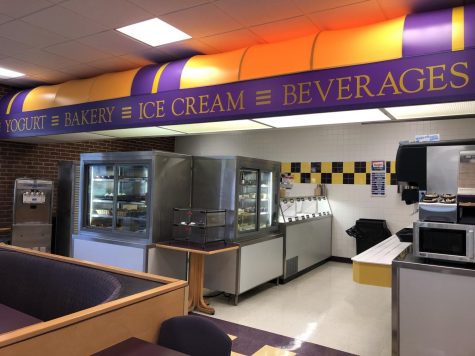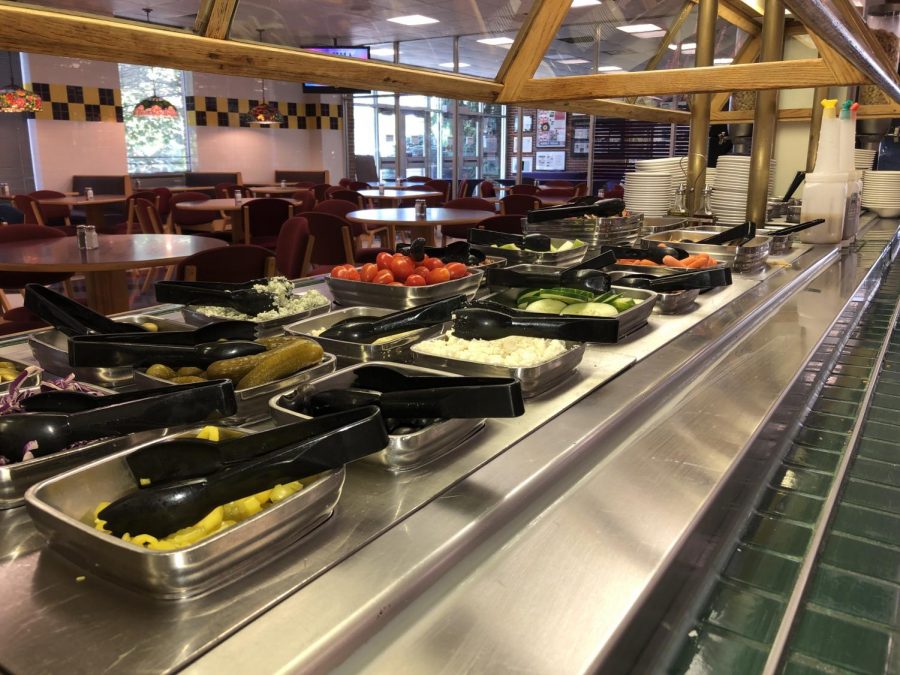Is it possible to eat healthy at AU?
Ingredients on the salad bar in Convo are freshly prepared each day.
September 5, 2019
The freedom of college quickly lends itself to the opportunity for a healthy or not-so-healthy lifestyle. The Rec Center offers many opportunities for physical improvement such as cardio machines, indoor track, climbing wall and intramural sports. Some may wonder if the same can be said for the food offered on campus.
Convo, Eagles’ Nest, Tuffy’s Smoothie Bar, COBE Cafe and Schar Cafe make up the majority of where AU students get their food.
The award-winning dining hall provides daily specials, salad bar and deli sandwiches, to name a few of the choices available. AU has taken several initiatives to ensure that healthy options are among the mix.
General Manager of Dining Operations, Fred Geib, helped foster the salubrious station that was added last year.
“We have added organic and non-GMO items to that list,” Geib said. “It is a dairy free and gluten free station.”
This heavily benefits students with allergies and those looking to make healthy choices, he said. Convo also provides tofu, almond and soy milk, vegan and black bean burgers, soy cheese and cauliflower pizza crust to accommodate to the needs of students.
Geib suggests visiting the pasta station and salad bar for fresh vegetables. As for the famous rotisserie chicken, it is fresh and never frozen.
“The chicken that we purchase comes from Gerber poultry located in Kindron, OH,” he said. “It’s essentially an organic product.”
AU has recently started buying romaine and leaf lettuce from a local seller out of Shiloh, OH. Another organic food, the grower does not add additional chemicals or fertilizers, Geib said.
Close to 30% of AU’s food items are locally purchased.
“There’s tons of healthy options in the dining hall,” he said. “You just really need to want to select those, whether it’s a cheeseburger or a piece of salmon.”
Denise Reed, a registered dietician and the director of the AU Dietetics program, believes the stressful college environment can influence students to choose non-nutritious foods.
“A student’s schedule changes, sleep habits take a hit and now you have foods available that you may not normally have at home,” she said.
Nonetheless, it is human nature to gravitate towards unhealthy foods from time to time, Reed said.
The Dietetics program frequently works with Geib and the whole food service department to brainstorm ideas for healthy food options.
A few years ago, the dietetic students performed survey research to determine which types of fish AU students would be interested in having available at Convo, she said.
Geib works well with the Dietetics program, Reed said. “He’s happy to try to institute our ideas as long as he thinks there’s going to be a demand.”
The most detrimental health risk to choosing non-nutritious foods is possible weight gain in the future, Reed said.
“When we talk about the freshman 15, research shows most people may only gain a couple of pounds,” she said. “But by making those unhealthy choices, their body composition might change.”
It is not so much about the short term effect, but rather the long term effect that can increase disease risk, Reed said.
“If you don’t start to make good eating habits at this age when you’re a young adult, you’re less likely to think that you need to eat healthy when you’re older,” she said. “It’s not like you all of a sudden become wiser when you’re 30.”
According to Reed, the most important thing to remember in Convo is portion control.
“Think vegetables and fruits first, then think about what protein you want to go with that,” she said. “I would say all proteins are okay, they’re just not created equal.”
Choose proteins that are baked, broiled or grilled and limit the amount of times eating fried foods, Reed suggested. Carbohydrates are okay as long as they do not take up the whole plate.
“If you incorporate those fruits and vegetables, you only have a small area left anyway,” she said.
Dining Services also has a consulting dietitian on staff to help students make healthier decisions.
“If students truly are not sure what is considered a healthy option, email me and I will connect them with our dietitian, Theresa Swain,” Geib said. “It’s a free service to students on any meal plan.”
Geib recognizes that everyone has a different metabolism and may need help with a specific area of healthy eating.
Senior soccer player and Marketing major, Emily Ledbetter, believes there could be a larger variety of healthy foods offered on campus.
“I always go to convo for dinner and I usually go to the rotisserie section,” she said. “But it’s easy to get tired of the chicken.”
With a separate class and soccer schedule, sometimes her only food option is Eagles’ Nest.
“All the food is fried, it’s not nutritious” Ledbetter said. “They have a salad bar but if you’re just eating salad all the time it won’t fill you up especially when we’re burning more calories everyday.”
Geib admits Nest’s menu is not designed to be healthy. It was really only built to serve faculty and staff.
“It’s morphed into this animal,” he said. “We’ve had to change and revamp things and add production areas.”
While there are many fried foods, the grab-n-go options tend to be fresher. Geib and the Dietetics program also worked to implement carrots and celery as a side choice.
Reed emphasises the importance of choosing a healthy side at Nest.
“Even if you know this isn’t the best choice of a sandwich, it probably has a lot of calories, balance it out with something that doesn’t,” she said. “Consider a more nutrient-dense food, which means a lot of good nutrients for a lesser amount of calories.”
Avoid chips, salads with heavy dressing, and all packaged foods, Reed said. Choose the fresh options.
Tuffy’s uses IQF fruits which stands for individually quick frozen, Geib said. The fruits have not been processed and other items that are needed for the smoothies are natural.
“A lot of smoothie places you go to in university settings, they’re using a base,” he said. “I think that’s what sets us apart from other universities, we take it to the next level.”
When it comes to dessert bar, commonly referred to as “fat bar,” Reed advises students to save dessert for a special occasion, like doing well on a test.

Despite its cringe-worthy nickname, Geib believes those selections are necessary to complete the dining hall.
“It’s about choices and moderation,” he said. “Instead of getting two scoops of ice cream, get one.”
Ledbetter loves fat bar and sees the value in treating herself to a sweet treat every so often.
To avoid overeating, Reed suggests students eat with friends and never go into Convo on an empty stomach.
“When people slow down and have conversations while they’re eating, they tend to eat more slowly and when people eat more slowly they eat less,” she said. “It takes a good 30-40 minutes for your brain to pick up that your stomach is full.”
If there is a food or meal you would like to see on campus, Geib is always willing to take suggestions. His only requirement is that people will eat the product.

“We can quickly make decisions and change the menu because we report to the university,” he said.
It is possible to eat healthy at AU, but it is a matter of selection. “It’s also about maintaining an exercise level, it’s a combination of both,” Geib said.



